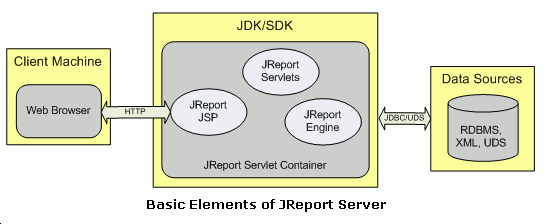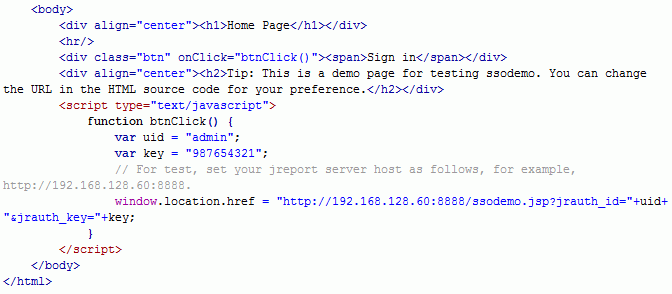 Previous Page Next Page
Previous Page Next Page
JReport Server provides a working web application as part of the product mix. This web application is implemented as a group of JSP pages and servlets that run in a Java web server's servlet container. JReport Server controls access to these JSP pages and servlets by requiring that a user be logged in to a web session before the JSP pages or servlets run.
The security framework of JReport Server also allows for Single Sign On so that a user only needs to login to an existing application and not need to do another login to access the JReport Server web pages.

This section introduces the web page security mechanism of JReport Server and how to use Single Sign On respectively.
JReport Server provides a working set of JSP pages and servlets that form a web application to schedule and run reports, view results and so on. This web application is only available to registered users who identify themselves and log in to JReport Server. An administrator can register users, set passwords for them, associate them with groups and roles and grant them permissions which is necessary for accessing the resources on JReport Server. This database of user information is used to validate the user name and password that is used to log in to the web application.
The sample in <install_root>\help\samples\APISecurity\LoginLogout can help you learn about web page security. It contains a set of JSP pages that can be run to try out various styles of accessing a JSP page to see how the login dynamics works. The entry point to the set of JSP pages is loginIndex.jsp. Read the comments in the JSP pages to understand how to run the demonstration.
The following details how the web page security check is processed on JReport Server.
Only logged-in users may access the web pages
When accessing JReport Server users should log in firstly. Once a user logs in to the web application he can access the web pages.
Each JSP page and servlet in the web application starts off with code that checks if the current HTTP Request is from a user who is already logged in. If it is, the rest of the code executes because this user is a known user. There may be more permissions checks within the code to control the specific request, but the user is allowed to access the web page.
If the current HTTP Request is not from a user who is already logged in, then the code attempts to log in the user using information available in the current HTTP Request, which may come from the following:
If it is not possible to log in a user, then the code recognizes that it is an unauthorized request and does not allow the rest of the code to execute. It may send back response to pop up the login dialog on the browser or may do something else depending on SSO implementation.
Validation of users during login
When the user name and password are obtained, JReport Server will validate if the login credentials match to a JReport Server user. The built-in system for doing this looks at the information for the set of users that are registered in JReport Server. It validates whether the password is correct for the given user name.
JReport Server also defines the AuthenticationProvider Java interface that developers can implement to do the validation using an application's user database. For more information, see Customized Implementation of the Security API.
Permission control
Once a web page is deemed accessible following the rules for login and validation, the JSP page or servlet is allowed to run. However it may be that the logged in user does not have permission to do the requested operation or have rights for the target resource of the operation. This aspect of whether the user is authorized for the request is determined by JReport Server evaluating the permission information.
For developer users JReport Server also defines the AuthorizationProvider Java interface that can be implemented to replace the built-in system for evaluating permissions and determining authorization. For more information, see Customized Implementation of the Security API.
JReport Server's web pages are built to work with an existing web application. In particular, it is possible to set up the web server so that users of the website can login to an existing web application and have that login grant them access to the JReport Server web pages. This is called the Single Sign On feature.
Single Sign On is done by developers implementing the class defined by the JReport Server Java interface HttpExternalAuthorized and telling JReport Server to use that implementation. The implementation can be aware of the application's technique for managing login state in the servlet session. This code can tell JReport Server which user is logged in. The implementation can redirect the user to the application's login workflow if the request is not from a logged-in user.
This system gives the user one spot in the application to login. A successful login there will allow the user to run JReport Server web pages without doing another login dialog.
JReport Server is told to use the local implementation of ExternalAuthorized in two ways.
The system property jrs.httpExternalAuthorized is used to hold the name of the class that implements HttpExternalAuthorized.
If the name of the class is DemoExternalAuthorized.java, then change the script file that starts up JReport Server to include the parameter string: -Djrs.httpExternalAuthorized=DemoExternalAuthorized.
The following shows an example:
CREATE TABLE jr_auth(auth_key varchar(64), auth_uid varchar(256) NOT NULL, PRIMARY KEY(auth_key))
Insert testing data for an example:
insert into jr_auth (auth_key, auth_uid) values('987654321', 'admin');
Tip: jr_auth includes the inserted/updated data. auth_uid should be a JReport Server user name (the login user).
<server_install_root>\help\samples\APISecurity\SSO\config.
driver=com.mysql.jdbc.Driver
dbUrl=jdbc:mysql://IP_Address:3306/test
dbUser=root
dbPassword=1234
<server_install_root>\help\samples\APISecurity\SSO <server_install_root>\help\samples\APISecurity\SSO\lib.<server_install_root>\bin to add the following in the class path:
<server_install_root>\help\samples\APISecurity\SSO\. You need to add its absolute path C:\JReport\Server\help\samples\APISecurity\SSO\.-Djrs.httpExternalAuthorized=DemoExternalAuthorized.
The class DemoExternalAuthorized in the example is used to implement the interface HttpExternalAuthorized. Once the class is successfully loaded, after JReport Server starts up you would be able to get the following message on the server console: DemoExternalAuthorized class is loaded. If you want to edit the authorization method, you just need to edit the method getExternalAuthorizedUser in DemoExternalAuthorized.
<server_install_root>\help\samples\APISecurity\SSO.

<server_install_root>\help\samples\APISecurity\SSO.

Tip: Do not modify the two parameter names when using ssodemo.jsp we provided, or there will be exceptions. If you need to modify the parameter names, change them in all the three files: login.html, ssodemo.jsp, and DemoExternalAuthorized.java.
The Java API class HttpUserSessionManager has a method for setting the ExternalAuthrized object that JReport Server uses.
If the name of the package is com.mycorp.myHttpExternalAuthorized, then in a JSP page, connect to JReport Server, then pass an instance of the class object for myHttpExtneralAuthorized as the parameter in the method HttpUserSessonManager.setHttpExternalAuthorized().
|
There are examples of implementations of the ExternalAuthorized Java interface in the sample source files that come with JReport Server. Look in the folder <install_root>\help\samples\APISecurity\SingleSignOn. Read the comments in the source code for more information about Single Sign On and how the Java interface is used.
In that same SingleSignOn folder are several JSP pages that can be placed into the public_html\jinfonet folder and run as web applications to exercise and demonstrate how Single Sign On works. The file customIndex.jsp is the entry point page. It has comments inside it on how to run the demonstration.
Notes: